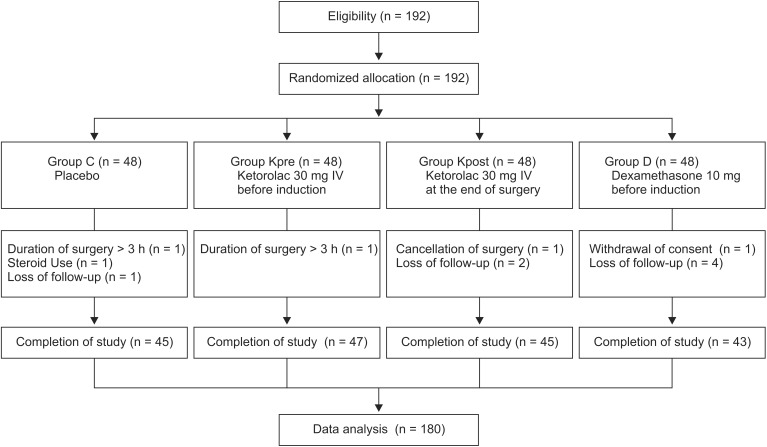1. Ryu JH, Yom CK, Park DJ, Kim KH, Do SH, Yoo SH, et al. Prospective randomized controlled trial on the use of flexible reinforced laryngeal mask airway (LMA) during total thyroidectomy: effects on postoperative laryngopharyngeal symptoms. World J Surg 2014; 38: 378-384. PMID:
24146195.


2. Jung TH, Rho JH, Hwang JH, Lee JH, Cha SC, Woo SC. The effect of the humidifier on sore throat and cough after thyroidectomy. Korean J Anesthesiol 2011; 61: 470-474. PMID:
22220223.



3. Christensen AM, Willemoes-Larsen H, Lundby L, Jakobsen KB. Postoperative throat complaints after tracheal intubation. Br J Anaesth 1994; 73: 786-787. PMID:
7880666.



4. Xu YJ, Wang SL, Ren Y, Zhu Y, Tan ZM. A smaller endotracheal tube combined with intravenous lidocaine decreases post-operative sore throat - a randomized controlled trial. Acta Anaesthesiol Scand 2012; 56: 1314-1320. PMID:
22999067.


5. Bagchi D, Mandal MC, Das S, Sahoo T, Basu SR, Sarkar S. Efficacy of intravenous dexamethasone to reduce incidence of postoperative sore throat: A prospective randomized controlled trial. J Anaesthesiol Clin Pharmacol 2012; 28: 477-480. PMID:
23225928.



6. Thomas S, Beevi S. Dexamethasone reduces the severity of postoperative sore throat. Can J Anaesth 2007; 54: 897-901. PMID:
17975234.


7. Jung H, Kim HJ. Dexamethasone contributes to the patient management after ambulatory laryngeal microsurgery by reducing sore throat. Eur Arch Otorhinolaryngol 2013; 270: 3115-3119. PMID:
24057101.


8. Ostrov CS, Sirkin SR, Deutsch WE, Masi RJ, Chandler JW, Lindquist TD. Ketorolac, prednisolone, and dexamethasone for postoperative inflammation. Clin Ther 1997; 19: 259-272. PMID:
9152565.


9. Paiva-Oliveira JG, Bastos PR, Cury Pontes ER, da Silva JC, Delgado JA, Oshiro-Filho NT. Comparison of the anti-inflammatory effect of dexamethasone and ketorolac in the extractions of third molars. Oral Maxillofac Surg 2016; 20: 123-133. PMID:
26572899.



10. Stout DM, Bishop MJ, Dwersteg JF, Cullen BF. Correlation of endotracheal tube size with sore throat and hoarseness following general anesthesia. Anesthesiology 1987; 67: 419-421. PMID:
3307536.


11. Friedman PG, Rosenberg MK, Lebenbom-Mansour M. A comparison of light wand and suspension laryngoscopic intubation techniques in outpatients. Anesth Analg 1997; 85: 578-582. PMID:
9296412.


12. Newcombe RG. Interval estimation for the difference between independent proportions: comparison of eleven methods. Stat Med 1998; 17: 873-890. PMID:
9595617.


13. Puyo CA, Tricomi SM, Dahms TE. Early biochemical markers of inflammation in a swine model of endotracheal intubation. Anesthesiology 2008; 109: 88-94. PMID:
18580177.


14. Wang JJ, Ho ST, Lee SC, Liu YC, Liu YH, Liao YC. The prophylactic effect of dexamethasone on postoperative nausea and vomiting in women undergoing thyroidectomy: a comparison of droperidol with saline. Anesth Analg 1999; 89: 200-203. PMID:
10389804.

15. Ryu JH, Han SS, Do SH, Lee JM, Lee SC, Choi ES. Effect of adjusted cuff pressure of endotracheal tube during thyroidectomy on postoperative airway complications: prospective, randomized, and controlled trial. World J Surg 2013; 37: 786-791. PMID:
23334802.


16. Rahimi M, Makarem J. Effects of diclofenac epolamine patch on postoperative sore throat in parturients after cesarean delivery under endotracheal general anesthesia. Acta Anaesthesiol Taiwan 2009; 47: 17-21. PMID:
19318295.


17. Ozaki M, Minami K, Sata T, Shigematsu A. Transdermal ketoprofen mitigates the severity of postoperative sore throat : [Le kétoprofène transdermique réduit le mal de gorge postopératoire]. Can J Anaesth 2001; 48: 1080-1083. PMID:
11744583.


18. Agarwal A, Nath SS, Goswami D, Gupta D, Dhiraaj S, Singh PK. An evaluation of the efficacy of aspirin and benzydamine hydrochloride gargle for attenuating postoperative sore throat: a prospective, randomized, single-blind study. Anesth Analg 2006; 103: 1001-1003. PMID:
17000820.


19. Thang'a P, Kamya D, Mung'ayi V. Effects of intravenous diclofenac on postoperative sore throat in patients undergoing laparoscopic surgery at Aga Khan University Hospital, Nairobi: a prospective, randomized, double blind controlled trial. Afr Health Sci 2013; 13: 999-1006. PMID:
24940324.



20. Pendeville PE, Van Boven MJ, Contreras V, Scholtes JL, Fosseur G, Lechien P, et al. Ketorolac tromethamine for postoperative analgesia in oral surgery. Acta Anaesthesiol Belg 1995; 46: 25-30. PMID:
7618425.

21. Trindade PA, Giglio FP, Colombini-Ishikiriama BL, Calvo AM, Modena KC, Ribeiro DA, et al. Sublingual ketorolac and sublingual piroxicam are equally effective for postoperative pain, trismus, and swelling management in lower third molar removal. Oral Surg Oral Med Oral Pathol Oral Radiol 2012; 114: 27-34. PMID:
22732846.


22. Rooks WH 2nd, Maloney PJ, Shott LD, Schuler ME, Sevelius H, Strosberg AM, et al. The analgesic and anti-inflammatory profile of ketorolac and its tromethamine salt. Drugs Exp Clin Res 1985; 11: 479-492. PMID:
3879752.

23. Rooks WH 2nd, Tomolonis AJ, Maloney PJ, Wallach MB, Schuler ME. The analgesic and anti-inflammatory profile of (+/-)-5-benzoyl-1,2-dihydro-3H-pyrrolo[1,2a]pyrrole-1-carboxylic acid (RS-37619). Agents Actions 1982; 12: 684-690. PMID:
6984594.


24. Puyo CA, Dahms TE. Innate immunity mediating inflammation secondary to endotracheal intubation. Arch Otolaryngol Head Neck Surg 2012; 138: 854-858. PMID:
22986720.


25. Ong KS, Tan JM. Preoperative intravenous tramadol versus ketorolac for preventing postoperative pain after third molar surgery. Int J Oral Maxillofac Surg 2004; 33: 274-278. PMID:
15287311.














